| |
Bayonet Markings
of the Imperial German
Colonial and Overseas Forces
|
|
| |
Imperial German bayonets were
usually marked in several ways which tell us a lot about the history of each
individual weapon. Sadly for the historian, while most bayonets had their
full compliment of markings before being issued not all bayonets did.
During the First World War bayonet markings were frequently not
applied and became quite rare. There are three markings to especially
look out for on a bayonet. The unit and weapon number markings
(usually on the hilt and scabbard), the manufacturer's marking
(usually on the flat of the blade near the hilt) and the monarch's
monogram and inspection date (usually on the blunt side of the blade).
|
|
| |
|
|
| |
|
|
| |
Unit and Weapon
Number Markings on the Hilt |
|
| |

Unit Markings of the South West
African Schutztruppe
"K.S. 2183." on a kS98 bayonet
and scabbard
Photo
© Roy Williams |
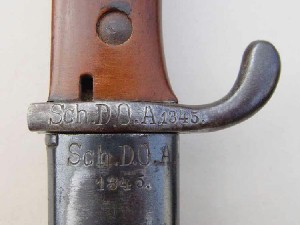
Unit Markings of the
East African Schutztruppe
"Sch. D.O.A.
1345." on a kS98 bayonet and scabbard
Photo
© Roy Williams |
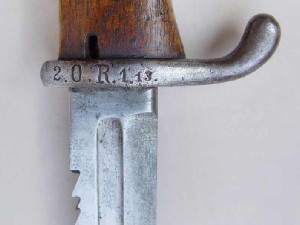
Unit
Markings of the 2nd East Asian Infantry Regiment
"2.O.R.1.13" on an S98aAS bayonet
Photo
© Roy Williams |
|
|
|
|
Upon issue to their
unit, most bayonets were stamped across the hilt with a
series of initials and numbers denoting the unit it was issued to and an
individual weapon number ("Waffe Numer").
For example a bayonet
marked "III.SB. 2.66." belonged to the III. Seebatallion, 2nd company,
weapon number 66 and a bayonet marked "Sch. D.O.A. 1116." belonged to the
Schutztruppe of German East Africa, weapon number 1116.
There were many
variations on unit markings but the most common for overseas
troops were-
KS- South West African Schutztruppe (Kaiserliche
Schutztruppe)
SchDOA- East African Schutztruppe (Schutztruppe Deutsch
Ost Afrika)
SchK or SK- Cameroon Schutztruppe (Schutztruppe
Kamerun)
PT- Colonial Police (Polizeitruppe)
SB- Marine Infantry (Seebataillon)
OR- East Asian Infantry (Ostasiatische Infanterie
Regiment) When company,
battalion and regimental numbers were used. companies and
regiments were always referred to in Arabic numerals (eg. 1, 2, 3,
4) while battalions were designated with Roman numerals (eg. I, II,
III, IV).
The weapon numbers usually ran in
consecutive order from the first issue of that type of bayonet to that
unit. From surviving examples it seems that when new models of bayonet
were introduced the series of weapon numbers started over again. In some
cases it seems from surviving examples that gaps were left in the
numbering system, perhaps starting new batches on the nearest rounded up
number.
For
example S71/84 bayonets were issued in East Africa before kS98 bayonets
and yet a S71/84 has been recorded with the markings "Sch. D.O.A. 1116."
and a kS98 has been recorded marked "Sch D.O.A. 208.". So it
would seem that the weapon number system started again either when each
new batch of bayonets arrived in the colony or at least when the kS98 was
introduced.
The unit numbers on bayonet hilts
and their scabbards matched when first issued but it is not
unusual to see mismatched numbers in modern collections. It
seems that some of these mix ups may have been made by recent
traders but the quantity of mismatches leads one to believe they
were often used like that perhaps when one blade broke and
another scabbard went missing.
It is not uncommon to see
colonial bayonets with previous regular army issue markings
cancelled out.
These unit and weapon number markings were also
used on bayonet
scabbards and on other weapons such as rifles, pistols
and swords.
|
|
|
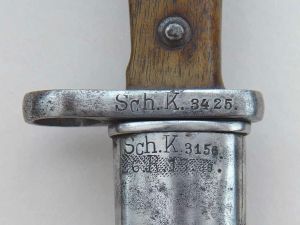
Unit Markings of the Cameroon
Schutztruppe
"Sch. K. 3425." on an
S71/84 bayonet and "Sch. K. 3158." on the scabbard.
Note the cancelled out previous unit markings. They read
"26.R.13.38.", showing
it have previously been issued to the 26th Magdeburg
Infantry Regiment ("Infanterie-Regiment. Fürst Leopold von
Anhalt-Desau (1.Magdeburgisches) Nr.26").
Photo
© Roy Williams
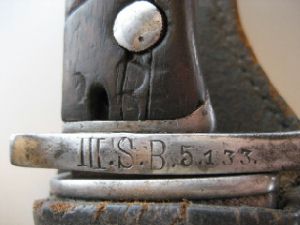
Unit Markings of the III.
Seebataillon
The markings "III
SB 5.133" show this bayonet to have been issued to the 5th
(Mounted) Company of the III. Seebataillon based in
Tsingtao. Being mounted infantry rather than cavalry, the
5th Company carried bayonets rather than swords.
Photo © Dow Cross |
|
|
| |
|
|
| |
|
|
| |
Manufacturer's Markings
on the
Blade |
|
| |
|
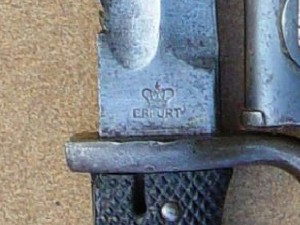
Crowned Erfurt
factory Markings
on a kS98 from the
South West African Schutztruppe
Photo © Chris Wood |
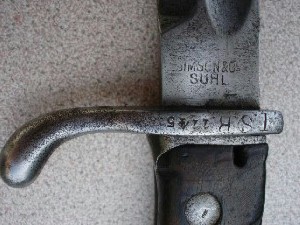
Simson & Co of
Suhl Markings
on an S98/05nAS from the I. Seebataillon.
Photo © Chris Wood |
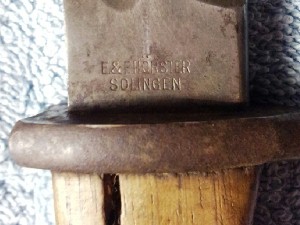
E&F Hörster of
Solingen Markings
on a 1913 wooden gripped kS98 from the East African
Schutztruppe
Photo © Stephen du Preez |
|
|
|
The name of the
manufacturer and sometimes their
town was usually marked
on the flat of the blade near the hilt. The factory markings appeared
upside down to the hilt markings. Occasionally bayonets have two different
manufacturer markings on each side of the blade. This is sometimes
due to one factory making the blade and another assembling or
modifying the bayonet. Many factories produced bayonets
for the German imperial army as well as small companies making privately
tailored edged weapons mostly for officers, NCOs and one year volunteers. Most of these
factories were in the Central German industrial areas
of the Ruhr in the West or Thuringia in Prussian
Saxony. Some of
the most notable manufacturers were-
Erfurt
The most commonly seen factory markings on bayonets
of the Imperial German era are those of the Royal Prussian Army works at Erfurt
in Prussian Thuringia. The Royal Prussian armoury had been
established at Erfurt in 1862. Their marking had the Royal
Prussian crown above the word Erfurt.
Simson and Company
Simson and Co. was
founded in Suhl, in Prussian Saxony by brothers, Löb and Moses Simson in
1856. They made firearms and edged weapons as well as bicycles and
motor vehicles. After the Treaty of Versailles limited the German
army to purchasing firearms only from one outlet, Simson & Co was
chosen. The Jewish family owners were forced to flee Nazi
persecution in 1936 and the factory was from then run as part of a
larger group of metal works as the "Berlin-Suhler Waffenwerke"
or BSW (which was jocularly known by locals as "Bis Simson
Wiederkommt" or "until Simson returns").
From 1945 the Soviets
took control and part of the factory was dismantled and taken to the
Soviet Union. In 1952 the company began operating again under the Simson name producing hunting rifles, bicycles and motorbikes
(including the famous Simson Schwalbe moped). Like many East German
companies it did not survive the transition to a market economy in
the 1990s and was forced to declare bankruptcy in 2003.
Recommended External Link - Wikipedia Page on
Simson & Co.
E & F Hörster
The Hörster factory was in
Solingen, near the Ruhr. Solingen is famous for its knife manufacture to
this day. They originally
made bayonets marked as F Hörster and from the mid-1870s the company became
E & F Hörster.
One particular batch of E & F Hörster
bayonets are of special interest to colonial collectors.
Every 1913 Hörster kS98 with wooden grips that has so far been
noted with a unit mark, belonged to the Schutztruppe of the
African colonies. This particular model of kS98 was probably the
first to have the wooden grips with two screw bolts which became
standard soon after, as they were cheaper than the old chequered
leather grips and showed less tendency to rot in tropical
climates. VC Schilling
VC schilling were one of several arms factories
based in Suhl, in Prussian Thuringia along with
Erfurt and Simpson & Co. Schilling is of especial
interest to colonial collectors as the as the
factory that made the Pfm71/98 conversions for the
East Asian Pioneers. |
|
|
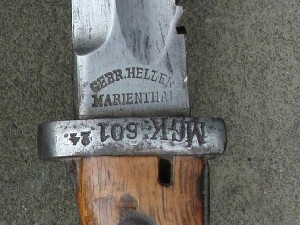
Heller Bros of Marienthal Markings
on an S84/98nAS bayonet from
the
601st MG Coy of the Pascha I Expedition. Note that 'brothers' in German is
abbreviated as "Gebr".
Photo
© Chris Wood
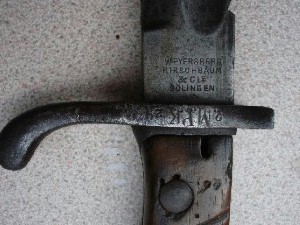
Weyersberg,
Kirschbaum & Co of Solingen
Markings
on a S98/05aAS Bayonet from the 2nd Naval Pioneer Company of
the Marinekorps Flandern. Note that 'company' is abbreviated in
German as "Cie".
Photo
© Chris Wood
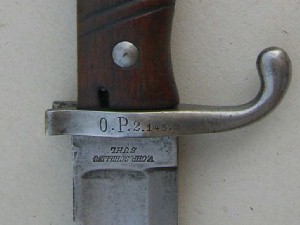
VC Schilling
of Suhl Markings
on a Pionier-Faschinenmesser 71/98 issued to the 2nd East Asian
Pioneer Company ("2.
Ostasiatische Pionier Kompanie"), of
the East Asian Expeditionary Corps.
Photos ©
Alain Ereth |
|
|
| |
|
|
| |
|
|
| |
|
|
| |
Monarch's Monogram and Date of Manufacture
Markings on the Blade |
|
| |
|
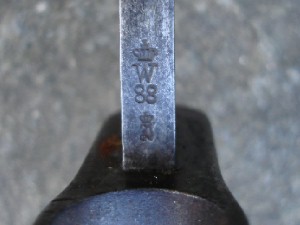
Wilhelm I or II
1888 Monogram
on an East African Schutztruppe S71/84, marked
with a crowned "W88". 1888 was the year of three Prussian Kings/German
Emperors. Wilhelm I died on 9th March 1888, his son and heir Frederick
III died on 15th June and was succeeded by his son, Wilhelm II, who
reigned up until his abdication in 1918.
Photo © Chris Wood |
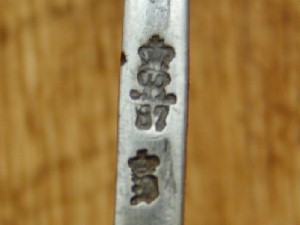
Albert of
Saxony 1887 Monogram
an East African Schutztruppe S71/84
with a crowned "AR87" monogram for King Albert of Saxony. The bayonet
was originally issued to the Royal Saxon army before entering
Schutztruppe service.
Photo ©
Old Smithy's Bayonet Pages
|

Frederick Wilhelm
IV
of Prussia 1861 Monogram
on a Naval FüsS60 marked with a crowned "FW61". King
Friedrich Wilhelm IV of Prussia died on 2 January 1861 so
unless this bayonet was made on the first day of the year, it is
likely that bayonets were still stamped with his monogram for
sometime after his death. Note also that early bayonets were marked on the flat of
the blade.
Photo
© Roy Williams |
|
|
|
| The date of manufacture or inspection was usually marked on the blunt
edge
of the blade. Note that this was the year that the bayonet left the
factory not necessarily when it was issued to a unit. Some bayonets were
kept in storage for several years before being issued.
The markings showed a crowned monogram of the reigning monarch
above the last two digits of the year. For example a bayonet marked "W00"
was made in the reign of Kaiser Wilhelm II, in the year 1900.
As most
overseas troops were imperial forces they usually bore the imperial
monogram. Kaiser Wilhelm II ascended to the royal Prussian and imperial
German thrones in 1888, before the first Schutztruppe were formed and
abdicated a few days before the last Schutztruppe surrendered so his
monogram features on the vast majority of bayonets used by Imperial German
overseas forces.
Bavarian, Saxon and Württemberg army units serving
overseas sometimes carried bayonets marked with their own
king's monogram.
Having said that, an example of a bayonet
used by a Bavarian company in the the East Asian Expeditionary Corps show
it to have the German Kaiser's monogram, rather than that of the Bavarian king.
So it seems that as the East Asian Expeditionary Corps were issued new bayonets before
their departure for China, they may all have had the German Kaiser's
monogram rather than those of the kings of
Bavaria, Saxony, and
Württemberg.
Bavarians, Saxons and Württembergers in the
Asienkorps and other army units in the Ottoman Empire and Central Asia
(most notably the largely Bavarian Georgian Expedition) during the First
World War may have carried state monograms. Although as the war dragged
on, bayonet markings became less common and fewer state distinctions were
seen in army use. Prussian or imperial insignia became common to many
state armies.
On rare occasions bayonets from other
German state armies were re-issued to the Schutztruppe. Two examples so
far been seen in modern collection, one a King Ludwig III of Bavaria
marked Cameroon Schutztruppe kS98 bayonet and the other an East African Schutztruppe
S71/84 with a monogram for King Albert of Saxony.
An exception to the imperial and royal
monogrammed date markings is seen on some naval S98 bayonets between
1906-07, which are marked with a crowned M (for "Marine") over a
two digit date.
Inspection markings to verify the bayonets'
quality were often placed directly below the manufacture date, as well as
on other parts of the bayonet.
Recommended External Link - See
Bajonett for full listings of the different German monarchs monograms.
|
|
|
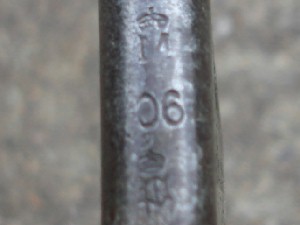
Imperial Navy 1906
Monogram
on an S98nA
bayonet issued to the 2nd Matrosen Division. Marked with a
crowned "M06" (the M standing for "Marine" or Navy). Most
naval bayonets are marked with the monogram of Wilhelm II or
unmarked. This "M" monogram has only been noted on S98 bayonets
produced in 1906 and 1907.
Photo © Chris Wood
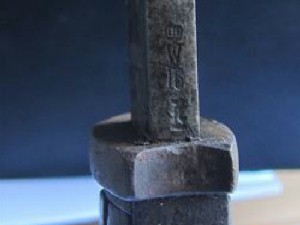
Wilhelm II 1916
Monogram
This example is on an S98/05 bayonet,
marked with a crowned "W16". It was
found by Staff Sergeant Selwyn Jorgensen of the 2/14 Australian
Infantry Battalion during the Battle for Kokoda in New Guinea,
successfully defending Port Moresby against the Japanese Army in
1942. The bayonet however, was almost certainly originally used by the
Imperial German army on the Western front during the First World
War. It cannot have been part of German New Guinea's armoury as
the colony had surrendered in 1914, two years before this bayonet
was manufactured. How it
ended up in New Guinea 28 years later is a mystery.
Photo © Murray Jorgensen |
|
|
| |
|
|
| |
|
|
| |
|
|
| |
Markings on other Weapons
Although this page specifically describes the markings seen on
bayonets, similar manufacture, date and unit markings were used on
most issued weapons as seen in the examples below.
|
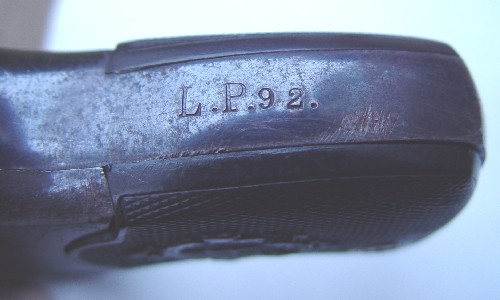
Pistol used
by the Colonial Police
The markings "L.P.92" on the butt of this Roth-Sauer Pistol
show it have been used by the Landespolizei of South West
Africa.
Photo © Alistair Hayes |
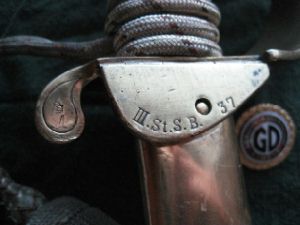
Naval Sword used by the
Marine Infantry
The markings "III. St. S.B. 37" show
this 1870/1880 pattern Naval sword to have been
issued to the depot unit or "Stamm" of the III.
Seebataillon based at
Cuxhaven in Germany.
Photo © Dow Cross |

Rifle Disc used by the East
Asian Expeditionary Corps
This is a rifle butt disc from a Gew98.
The markings
"6.O.R. 3.1.29"
are for the 6th East Asian Infantry Regt, 3rd Battalion,
1st Company, weapon number 29. The "6. Ostasiatische Infanterie Regiment"
were part of the 1900 East Asian Expeditionary Corps.
Photos © Gilles Sigro |
|
|
| |
|
|
|